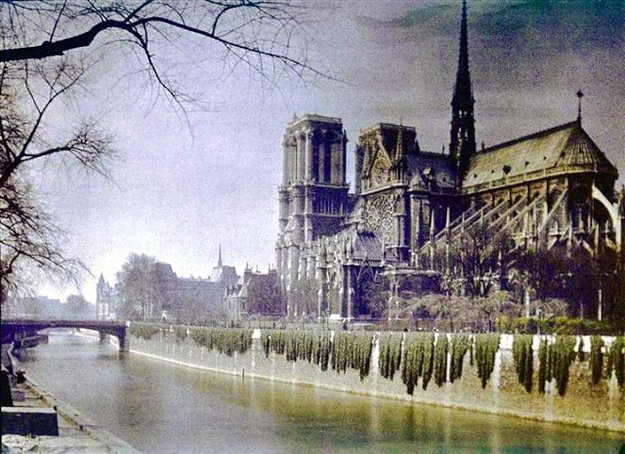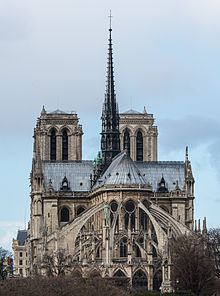Notre Dame de Paris


As the cathedral of the Archdiocese of Paris, Notre-Dame contains the cathedra of the Archbishop of Paris, currently Cardinal André Vingt-Trois. The cathedral treasury contains a reliquary, which houses some of Catholicism's most important relics, including the purported Crown of Thorns, a fragment of the True Cross, and one of the Holy Nails.
In the 1790s, Notre-Dame suffered desecration in the radical phase of the French Revolution when much of its religious imagery was damaged or destroyed. An extensive restoration supervised by Eugène Viollet-le-Duc began in 1845.
Architecture

The Notre-Dame de Paris was among the first buildings in the world to use the flying buttress. The building was not originally designed to include the flying buttresses around the choir and nave but after the construction began, the thinner walls grew ever higher and stress fractures began to occur as the walls pushed outward. In response, the cathedral's architects built supports around the outside walls, and later additions continued the pattern. The total surface area is 5,500 m² (interior surface 4,800 m²).
Many small individually crafted statues were placed around the outside to serve as column supports and water spouts. Among these are the famous gargoyles, designed for water run-off, and chimeras. The statues were originally colored as was most of the exterior. The paint has worn off. The cathedral was essentially complete by 1345. The cathedral has a narrow climb of 387 steps at the top of several spiral staircases; along the climb it is possible to view its most famous bell and its gargoyles in close quarters, as well as having a spectacular view across Paris when reaching the top.
Bells
The cathedral has 10 bells. The largest, Emmanuel, original to 1681, is located in the south tower and weighs just over 13 tons and is tolled to mark the hours of the day and for various occasions and services. This bell is always rung first, at least 5 seconds before the rest. Until recently, there were four additional 19th-century bells on wheels in the north tower, which were swing chimed. These bells were meant to replace nine which were removed from the cathedral during the Revolution and were rung for various services and festivals. The bells were once rung by hand before electric motors allowed them to be rung without manual labor. When it was discovered that the size of the bells could cause the entire building to vibrate, threatening its structural integrity, they were taken out of use. The bells also had external hammers for tune playing from a small clavier.
Organs and Organists
Though numerous organs have been installed in the cathedral over time, the earliest models were inadequate for the building. The first more noted organ[citation needed] was finished in the 18th century by the noted builder François-Henri Clicquot. Some of Clicquot's original pipework in the pedal division continues to sound from the organ today. The organ was almost completely rebuilt and expanded in the 19th century by Aristide Cavaillé-Coll.
The position of titular organist ("head" or "chief" organist; French: titulaires des grands orgues) at Notre-Dame is considered one of the most prestigious organist posts in France, along with the post of titular organist of Saint Sulpice in Paris, Cavaillé-Coll's largest instrument.
The organ has 7,952 pipes, with ca 900 classified as historical. It has 110 real stops, five 56-key manuals and a 32-key pedalboard. In December 1992, a two-year restoration of the organ was completed that fully computerized the organ under three LANs (Local Area Networks). The restoration also included a number of additions, notably two further horizontal reed stops en chamade in the Cavaille-Coll style. The Notre-Dame organ is therefore unique in France in having five fully independent reed stops en chamade.